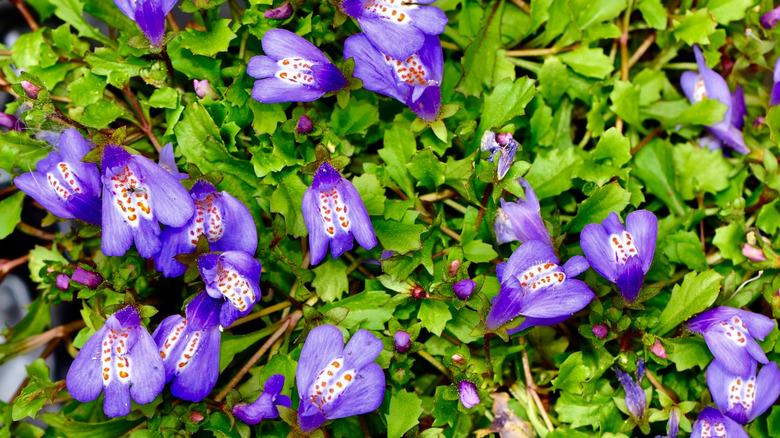The Colorful Ground Cover That Makes A Great Grass Alternative For Small Yards
Lawns don't have to be rational. Farming a turfgrass monoculture is a hobby, and as such is exempted from the normal rules of ... well, reason. But viewed from a perfectly logical point of view, there are alternatives to grass that do what grass does without a lot of grass's collateral damage — yanking mower starter cords (or, worse, replacing $200 electric motor batteries), poisoning everything in sight to suppress innocuous weeds, and spending a quarter of your weekend and nearly as much of your money growing a crop that's main benefit is being green (not the rarest trait among plants). One of the best alternatives to turfgrass is one you might not have heard about: A snapdragon relative called creeping mazus (Mazusmiquelii).
Of course, grass isn't always purely ornamental. It stabilizes soil, reduces erosion, and is pleasant to look at and walk on. Fortunately, creeping mazus has the same charms. The Himalayan native does all that and provides a habitat for pollinators, to say nothing of the blanket of tubular purple or white flowers it covers your lawn with in spring and summer. Creeping mazus forms a low, dense mat of serrated foliage, usually no more than 2 inches tall, that suppresses weeds and can be freely walked on and occasionally mowed. The perennial has interesting serrated foliage and spreads by rooting stems. You can grow creeping mazus in zones 5 through 9 in either full sun or partial shade (which makes it a good ground cover to fill in patchy areas in your lawn), but it does require consistently moist soil and a bit of compost.
But is creeping mazus invasive?
There's lots of confusion around whether creeping mazus belongs in lists of invasive garden plants to avoid, but there doesn't seem to be much real evidence that it is. In fact, it's sometimes described as invasive specifically in the northeastern United States. Normally, you might reasonably just avoid the risk. But given all the great qualities of creeping mazus as a lawn replacement, it's worth a look at the evidence. The University of Michigan Herbarium notes that creeping mazus occasionally becomes a garden and lawn weed, and rather cryptically says that a "white form" is common and "may escape;" none of which seems to rise to the level of invasiveness. But more specific resources are even less troubling.
The International Global Biodiversity Information Facility describes the plant's degree of establishment as "casual" (meaning that "individuals surviving outside of captivity or cultivation in a location with no reproduction") in the U.S., Italy, and Belgium. Mazus is listed in the United States Register of Introduced and Invasive Species and the BioOne Digital Library as a non-native species that's currently established (meaning it has a reproducing population) but not invasive. Creeping mazus is not listed in the Federal Noxious Weed List, the USDA's National Invasive Species Information Center, invasive.org's Mid-Atlantic Exotic Pest Plant Council Plant List, or the University of Georgia Center for Invasive Species and Ecosystem Health's 2016 Invasive Plant Atlas of the United States. So, while it's always better to use native plants for landscaping, creeping mazus is a pretty safe bet. However, before planting, it is best to check laws and regulations in your locality to ensure that creeping mazus is not considered invasive.

